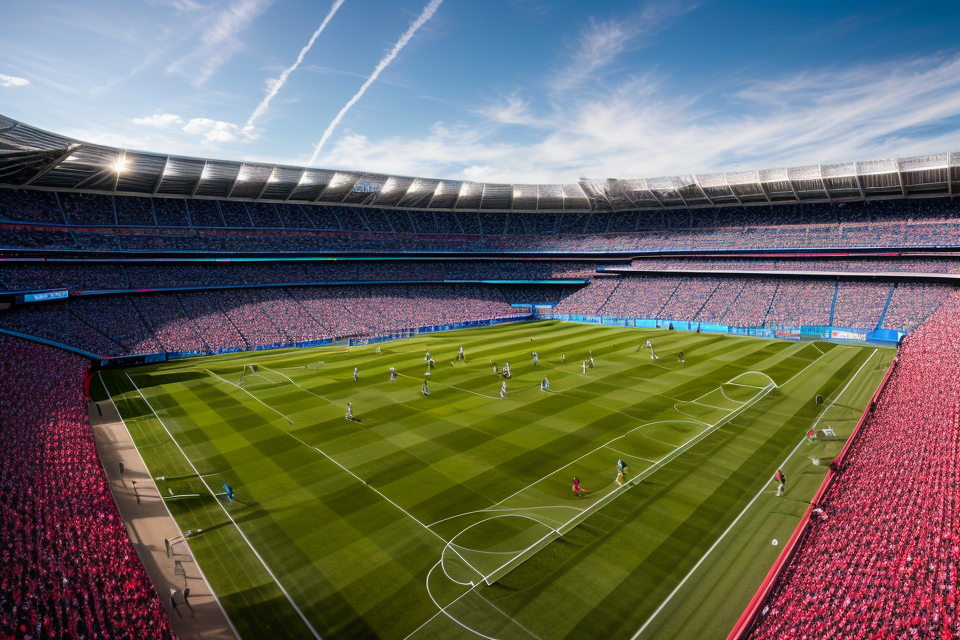Soccer, also known as football, is the most popular sport in the world. It is played in almost every country and has a massive following of fans who are passionate about the game. But why is soccer so popular? There are several reasons that contribute to its global appeal. One of the main reasons is that it is a simple game to understand and play, making it accessible to people of all ages and abilities. Additionally, soccer has a unique ability to bring people together, creating a sense of community and belonging. The excitement and drama of the game, combined with the skill and athleticism of the players, also contribute to its popularity. Whether you’re a die-hard fan or a casual observer, it’s easy to see why soccer has captured the hearts of people all over the world.
Soccer is the most popular sport in the world for several reasons. Firstly, it is a sport that is easily accessible to people of all ages and abilities, as it requires minimal equipment and can be played almost anywhere. Secondly, soccer is a sport that is deeply ingrained in culture and history, with a long and rich tradition in many countries around the world. Finally, soccer is a sport that is both physically and mentally challenging, requiring a combination of strength, speed, agility, and strategy. These factors, along with the excitement and drama of the game, have helped to make soccer the most popular sport in the world.
The Global Appeal of Soccer
The Sport’s Accessibility
One of the primary reasons why soccer is the most popular sport in the world is its accessibility. Unlike other sports that require expensive equipment or specialized facilities, soccer can be played almost anywhere with a ball and open space. This accessibility has made the sport accessible to people from all walks of life, regardless of their socioeconomic status or geographic location.
Here are some of the key factors that contribute to the accessibility of soccer:
- Affordable equipment: Unlike other sports that require specialized equipment, such as hockey or lacrosse, soccer only requires a ball and some basic footwear. This makes it an affordable option for people who may not have the financial resources to participate in other sports.
- No experience necessary: Soccer is a sport that is easy to learn and play, even for those who have never played before. The basic rules of the game are simple, and players can quickly learn how to control the ball and score goals.
- Can be played anywhere: Unlike sports that require specific facilities, such as basketball or tennis, soccer can be played almost anywhere. This makes it a popular choice for people who live in areas without access to sports facilities or for those who prefer to play outdoors.
- Social game: Soccer is a social game that encourages teamwork and cooperation. Players work together to achieve a common goal, and this sense of camaraderie is a significant part of the sport’s appeal.
Overall, the accessibility of soccer is a key factor in its popularity around the world. The sport’s affordability, ease of play, and social aspects make it accessible to people from all backgrounds and help to explain why it is the most popular sport in the world.
The Sport’s Popularity
- High viewership and attendance at matches
- According to a study by FIFA, the estimated global audience for the 2018 World Cup was 3.57 billion, making it the most-watched sporting event in history.
- Matches between top teams and clubs can attract tens of thousands of fans to the stadium, with some games even breaking attendance records.
- Large number of professional and amateur leagues
- From the English Premier League to La Liga in Spain, to the Bundesliga in Germany, there are numerous professional leagues around the world that attract top talent and large fan bases.
- Additionally, there are countless amateur leagues and pickup games that take place in communities around the globe, allowing for a wide range of skill levels to participate in the sport.
- Wide range of age and skill levels
- Unlike other sports that may require specialized equipment or training from a young age, soccer can be played with just a ball and a few friends.
- This accessibility has made it a favorite among people of all ages and skill levels, from children playing in the park to professionals competing at the highest level.
- Furthermore, the sport’s simplicity and ease of play have made it a popular choice for those looking to get involved in sports without the need for extensive training or equipment.
The Sport’s Cultural Significance
Soccer has a unique cultural significance that has made it an integral part of national identity in many countries around the world. It has the power to shape social and political dynamics, and is often seen as a symbol of unity and national pride.
- Integral part of national identity in many countries
- In countries like Brazil, Argentina, and Uruguay, soccer is not just a sport, but a way of life. It is deeply ingrained in the culture and history of these countries, and is seen as a reflection of their national identity.
- In many other countries, soccer is also a source of national pride, and is closely tied to the country’s sense of self and its place in the world.
- Highly influential in shaping social and political dynamics
- Soccer has the power to bring people together, regardless of their social or political background. It can be a unifying force, breaking down barriers and fostering a sense of community.
- At the same time, soccer can also be a powerful tool for social and political change. It can be used to challenge the status quo, and to promote social and political movements.
- Symbol of unity and national pride
- Soccer is often seen as a symbol of unity and national pride, bringing people together and fostering a sense of shared identity.
- This is particularly true in times of conflict or crisis, when soccer can provide a much-needed sense of hope and unity. It can be a powerful force for good, bringing people together and promoting a sense of community and shared purpose.
The Influence of Professional Soccer Players
Role Models and Inspiration
Professional soccer players have a significant impact on the sport’s popularity worldwide. They are not only admired for their athletic prowess but also for their role as positive influences in society. In this section, we will explore how professional soccer players serve as role models and inspiration for young players and the broader community.
Young players look up to and aspire to emulate professional players
Young soccer players often idolize professional players, and their performances on the field can inspire and motivate the next generation of players. The skill, technique, and passion displayed by professional players serve as an example for young players to follow. Many aspiring soccer players dream of emulating their heroes and achieving similar success in the sport. Professional players can also serve as a source of inspiration for young people who may not have access to top-level coaching or facilities, as they can use their favorite players as a guiding force to improve their own skills.
Players can influence positive social change
Professional soccer players can also have a significant impact on society beyond the field. They have the power to inspire positive change and raise awareness about important social issues. Many professional players use their platform to advocate for causes they are passionate about, such as promoting diversity and inclusion, supporting charitable organizations, or raising awareness about important global issues. This influence can help to create a more positive and socially conscious society, which can in turn increase the popularity of the sport.
Overall, the influence of professional soccer players as role models and inspirations is a significant factor in the sport’s popularity worldwide. Their performances on the field, their personal lives, and their commitment to social causes can all contribute to the sport’s appeal and its ability to bring people together.
Economic Impact
High salaries and endorsement deals for top players
The success of professional soccer players can have a significant impact on their personal finances. The highest-paid players can earn millions of dollars per year in salary alone, with many also securing lucrative endorsement deals with major brands. This level of financial success can make soccer an attractive career choice for talented athletes, who may be able to achieve a level of wealth and fame that is otherwise difficult to attain.
Significant revenue generated by professional leagues and teams
In addition to the high salaries paid to individual players, professional soccer leagues and teams also generate significant revenue. The money generated from ticket sales, television broadcasting rights, and sponsorships can be substantial, and is often used to fund the operations of the league or team, as well as to pay player salaries. This financial success can be a major factor in the popularity of soccer, as it provides a level of economic support that allows the sport to continue to grow and thrive.
Global Fan Base
Soccer players have a unique ability to transcend borders and become global icons. Their popularity extends far beyond the field, with millions of fans following their every move. One of the key reasons for this is the international nature of the sport. Soccer is played in almost every country around the world, and the best players often have a global following.
International competitions like the World Cup are a prime example of how soccer brings fans from all over the world together. The tournament is a showcase of the best players from countries all over the globe, and it attracts billions of viewers from every continent. Fans of different nationalities come together to support their teams, creating a shared experience that transcends cultural and political differences.
Moreover, the accessibility of soccer as a sport makes it easier for fans to connect with their favorite players. Unlike other sports, soccer doesn’t require expensive equipment or specialized training to play. This means that anyone, regardless of their background or financial situation, can enjoy the sport and feel a connection to the players.
Additionally, the personalities and stories of soccer players often resonate with fans on a deeper level. Many players have overcome significant obstacles to achieve their dreams, and their journey to success can serve as an inspiration to others. Fans also appreciate the passion and emotion that players bring to the game, which makes it all the more exciting to watch.
Overall, the global fan base of soccer is a testament to the power of the sport to bring people together. Whether it’s through international competitions or the personal stories of players, soccer has the ability to transcend boundaries and create a shared experience for fans from all over the world.
The Challenges of Being a Professional Soccer Player
Physical Demands
High level of physical fitness required
As a professional soccer player, one must possess a high level of physical fitness to succeed in the sport. This involves being able to run long distances at high speeds, have excellent endurance, and maintain peak physical conditioning throughout the entire season. The game of soccer is known for its high-intensity action, with players often covering miles on the field during each match.
Constant risk of injury
Another aspect of the physical demands of soccer is the constant risk of injury. Players are prone to injuries due to the high-impact nature of the game, which includes tackles, collisions, and the constant changing of direction at high speeds. Some of the most common injuries in soccer include muscle strains, ligament tears, and concussions. Despite the risks, many players continue to push themselves to the limit in order to achieve success on the field.
Overall, the physical demands of soccer are significant, and being a professional player requires a tremendous amount of dedication, hard work, and discipline to maintain the necessary level of fitness and avoid injury.
Mental Demands
Soccer is a sport that requires a high level of mental toughness and resilience from its players. The demands of being a professional soccer player go beyond physical fitness and technical skills. In this section, we will explore the mental demands of being a professional soccer player.
High Pressure to Perform Consistently
Soccer is a sport that is loved by billions of people around the world, and as a professional soccer player, you are under constant pressure to perform at a high level consistently. Fans, coaches, and teammates all have high expectations of you, and you must be able to handle the pressure and deliver on the pitch.
Consistency is key in soccer, and even the smallest mistakes can lead to losses and disappointment. Professional soccer players must be able to maintain their focus and concentration for 90 minutes or more, while also being able to adapt to changing circumstances on the field.
Mental Toughness and Resilience
Mental toughness and resilience are crucial qualities for professional soccer players. They must be able to bounce back from setbacks and challenges, both on and off the field. The pressure to perform at a high level, the scrutiny of the media, and the constant demands of fans and coaches can take a toll on a player’s mental health.
Professional soccer players must be able to develop coping mechanisms to deal with stress and anxiety, and must also be able to learn from their mistakes and use them as opportunities for growth and improvement.
In addition, players must be able to stay focused and motivated, even when faced with injuries, setbacks, or losses. They must be able to maintain a positive attitude and work hard to overcome challenges and obstacles.
The Importance of Mental Preparation
Mental preparation is a crucial aspect of being a professional soccer player. Players must be able to prepare themselves mentally for games and training sessions, and must also be able to stay focused and concentrated during matches.
Mental preparation involves visualization, positive self-talk, and developing a pre-match routine. Players must also be able to manage their emotions and stay level-headed, even in high-pressure situations.
In conclusion, the mental demands of being a professional soccer player are significant. Players must be able to handle the pressure to perform consistently, develop mental toughness and resilience, and prepare themselves mentally for games and training sessions. Only those who are mentally strong and prepared can excel in this demanding sport.
Balancing Personal and Professional Life
Being a professional soccer player requires a significant amount of time and dedication, both on and off the field. The demanding schedule of training, matches, and media obligations can make it difficult for players to maintain a healthy work-life balance. This challenge is particularly acute for young players who are just starting out in their careers and may be struggling to establish themselves both on and off the field.
One of the main challenges of balancing personal and professional life as a soccer player is managing the time commitment required for training and matches. Professional soccer players typically train for several hours each day, and they may also be required to attend team meetings, press conferences, and other media obligations. This can leave little time for players to pursue other interests or spend time with their families and friends.
Another challenge is the need to balance personal and professional life. Soccer players are often required to travel extensively, both domestically and internationally, which can disrupt their personal lives and make it difficult to maintain a stable home life. In addition, the intense pressure and scrutiny that comes with being a professional athlete can take a toll on players’ mental and emotional well-being, making it important for them to find ways to manage stress and maintain a healthy work-life balance.
Overall, balancing personal and professional life is a significant challenge for professional soccer players. It requires careful time management, prioritization, and a strong support system to help players navigate the demands of their careers while also maintaining their personal lives.
The Future of Soccer
Technological Advancements
Soccer has seen significant technological advancements in recent years, leading to improved equipment and training techniques. This has led to a higher level of play and increased interest in the sport.
Advancements in Equipment
Advancements in equipment technology have greatly improved the performance of soccer players. For example, the development of synthetic turf fields has allowed for better ball control and increased player safety. Additionally, advancements in soccer ball technology have led to improved flight characteristics and greater accuracy.
Training Techniques
Improved training techniques have also played a major role in the growth of soccer. With the help of technology, coaches can now analyze game footage and identify areas for improvement. This has led to more precise and effective training sessions, resulting in improved player performance.
Increased Use of Technology
The use of technology in soccer has also increased in recent years. For example, the introduction of video assistant referees (VAR) has greatly improved the accuracy of officiating, reducing the number of controversial calls. Additionally, technology is being used to track player performance and provide insights into areas such as ball possession and passing accuracy.
Overall, the advancements in equipment and training techniques, as well as the increased use of technology, have all contributed to the growth and popularity of soccer as a sport. As technology continues to evolve, it is likely that soccer will continue to benefit from these advancements, leading to even greater levels of play and increased interest in the sport.
Globalization
Increased participation and interest in international competitions
Soccer’s globalization has led to a surge in participation and interest in international competitions. This is primarily due to the increased exposure and accessibility of the sport to audiences worldwide. As a result, soccer has become a unifying force that transcends cultural, social, and economic barriers, bringing people together from different corners of the globe.
One of the most significant factors contributing to the growth of soccer’s popularity is the increasing number of international competitions. These competitions provide a platform for countries to showcase their skills and abilities, fostering a sense of pride and national identity. Consequently, these events have become a focal point for fans worldwide, who gather to support their teams and celebrate the sport’s camaraderie.
Furthermore, the rise of professional leagues and clubs in various countries has provided more opportunities for aspiring players to hone their skills and compete at higher levels. This has led to a significant increase in the number of talented players participating in international competitions, raising the overall standard of play. As a result, international competitions have become a showcase for the world’s best players, attracting fans from all over the globe.
Additionally, the increased availability of media coverage and technological advancements have made it easier for fans to access and engage with soccer content. With the proliferation of social media platforms and streaming services, fans can now follow their favorite teams and players from anywhere in the world, creating a global community of supporters.
Overall, the continued growth and popularity of soccer worldwide can be attributed to its ability to connect people across cultures and boundaries. The sport’s globalization has created a shared passion that transcends borders, making it the most popular sport in the world.
Social and Political Impact
Soccer has the potential to bring people together and promote positive social change. It is a sport that is played and enjoyed by people of all ages, genders, and backgrounds, making it a powerful tool for promoting unity and understanding.
Additionally, soccer continues to have a significant influence on national and international politics. The sport is often used as a platform for political leaders to connect with their constituents and promote their agendas. It is also used as a tool for promoting peace and understanding between different countries and cultures.
Moreover, soccer has been used as a means of promoting social and political change. For example, in countries where soccer is the most popular sport, it has been used to bring attention to important social and political issues. This has led to increased awareness and activism around these issues, and has helped to bring about positive change.
In conclusion, soccer has the potential to bring people together and promote positive social and political change. It is a powerful tool that can be used to promote unity, understanding, and activism, and will continue to play an important role in shaping the future of society.
Evolving Player Profile
Changing landscape of professional soccer, including increased focus on mental health and well-being
In recent years, there has been a growing recognition of the importance of mental health and well-being in professional soccer. This has led to a shift in the way that players are supported and cared for, both on and off the field. For example, many clubs now employ sports psychologists to work with players, helping them to manage the pressure and expectations that come with playing at the highest level. In addition, there is a greater emphasis on player welfare, with teams providing more comprehensive support for players who may be struggling with mental health issues.
Continued diversification of the sport, including more representation of women and marginalized groups
Soccer has always been a sport that is beloved around the world, but in recent years, there has been a growing push to make the sport more inclusive and diverse. This has led to a greater representation of women and marginalized groups in the sport, both on and off the field. For example, there are now more women’s soccer leagues and tournaments than ever before, and these leagues are attracting top talent from around the world. In addition, there is a greater focus on diversity and inclusion in the sport, with many teams and organizations working to promote diversity and combat discrimination.
FAQs
1. Why is soccer the most popular sport in the world?
Soccer is the most popular sport in the world for several reasons. One reason is that it is a simple game to understand and play, which makes it accessible to people of all ages and abilities. Additionally, soccer is a sport that can be played almost anywhere, with just a ball and a few friends. This has helped to spread the game to countries all over the world, where it has become a beloved pastime.
2. What is the history of soccer?
The history of soccer can be traced back to ancient China, where a game called “Cuju” was played. However, the modern game of soccer as we know it today began to take shape in England in the 19th century. It was from England that the game spread to other countries, including the United States, where it has become one of the most popular sports.
3. Why is soccer so popular in different countries?
Soccer is popular in different countries for a variety of reasons. In some countries, soccer is a symbol of national pride and identity. In others, it is a way of bringing people together and promoting social cohesion. Additionally, soccer is often seen as a sport that can help to promote physical fitness and healthy lifestyles.
4. What are some of the biggest soccer tournaments in the world?
Some of the biggest soccer tournaments in the world include the FIFA World Cup, which is held every four years and features teams from all over the world, and the UEFA Champions League, which is a tournament for the top teams in Europe. Other notable tournaments include the English Premier League, La Liga in Spain, and the Bundesliga in Germany.
5. Who are some of the most famous soccer players in the world?
There have been many famous soccer players throughout the years, but some of the most iconic include Diego Maradona, Lionel Messi, Cristiano Ronaldo, Pele, and David Beckham. These players are known for their skill, talent, and ability to inspire their teams and fans.



